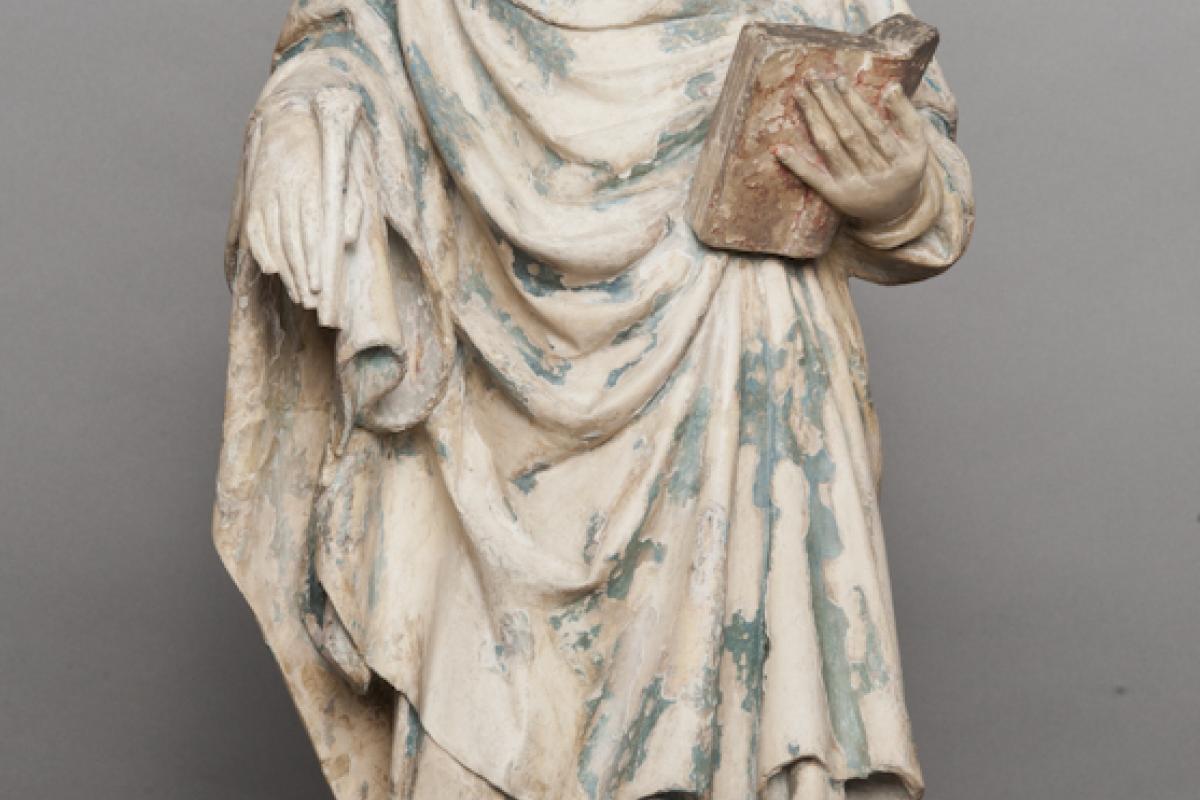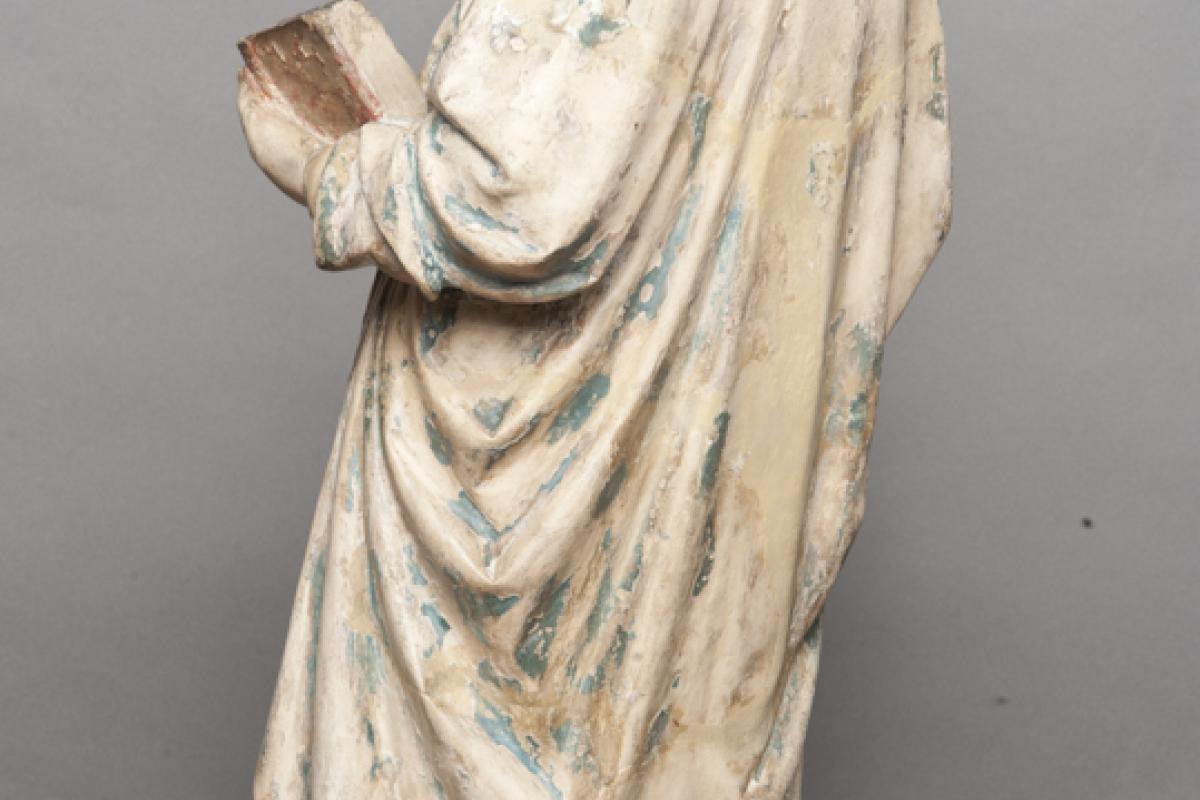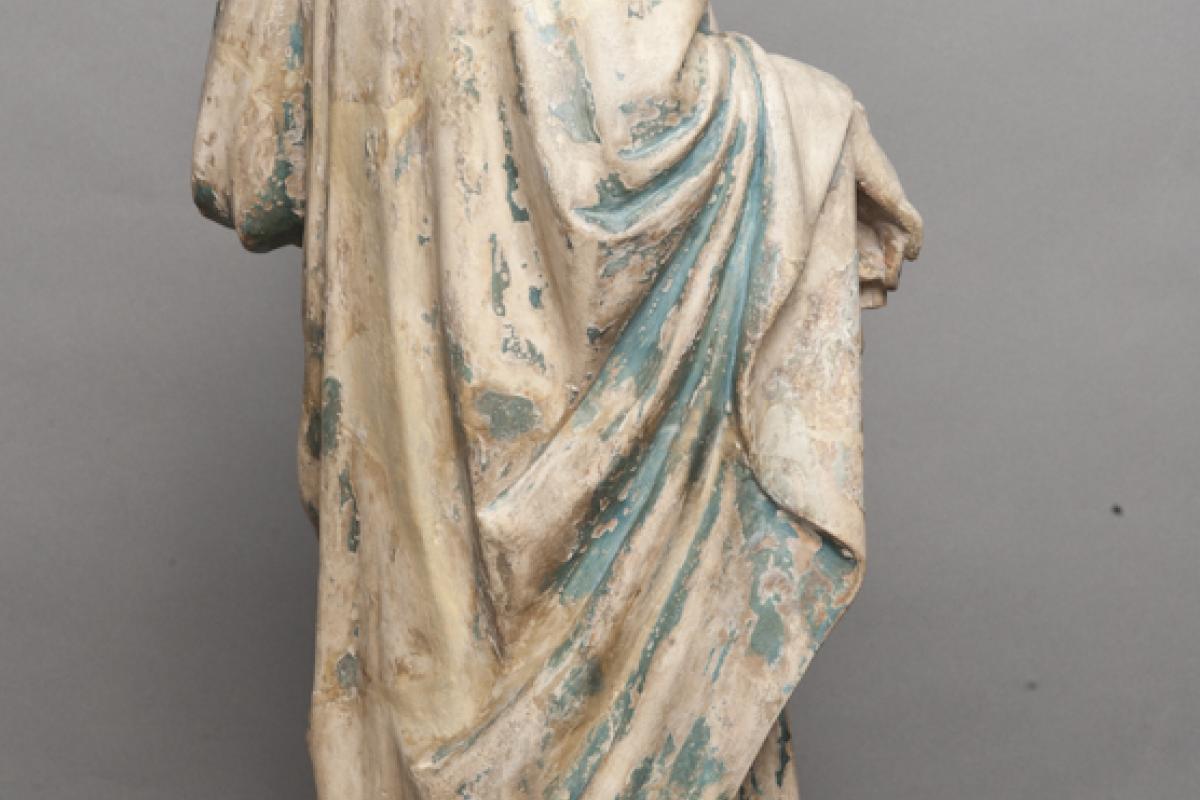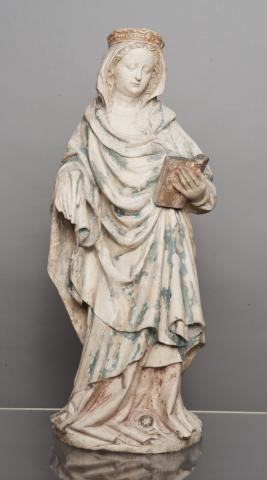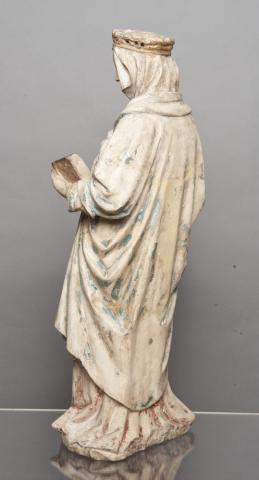Female Martyred Saint
Female Martyred Saint
Early Renaissance
French (Burgundy), 14th century
polychrome limestone
height 59.7 cm
width 21.3 cm
depth 12.7 cm
Portland Museum of Art, 44.22
Gift of Mrs. Arthur Stein in memory of Ernest Rosenfield
Allison Moody, Medieval Portland Senior Capstone Student, 2008
The Female Martyred Saint, a modestly sized sculpture at approximately 22 inches, is a beautifully preserved example of 14th-century French Gothic style. This style is visible in the materials, composition, and delicately rendered details. While she remains mostly intact, the Female Martyred Saint is missing some ornamentation from her crown, and most of the object held in her right hand. Originally brought to life with polychrome, the sculpture now only carries remnants of the original red, blue and gold polychrome. In the 14th century, smaller, free-standing sculptures gained popularity, adding variety to large, embedded facade projects. Altarpieces and tombs also incorporated individual sculptures of varying sizes, though something of this size and iconography is likely an object of personal devotion, or simply a privately owned sculpture.
This sculpture is designed to fit into a space and not be viewed in the round. This is evidenced by how the back is cut off to create a flat surface, allowing it to fit up against a wall or in a niche. The Female Martyred Saint shows how this effect was achieved more subtly: the back is somewhat flattened, but not cut away dramatically until the lower third portion at the back of the legs. Also, part of the base is broken off in the back. The Female Martyred Saint is a limestone sculpture: approximately two-thirds of the surface of France is carpeted with limestone, making it a common, local sculpture material. Due to the nature of creating a sculpture out of limestone, rough areas, or chisel marks are commonly visible as the polychrome wears off.
In addition to the broken remains of an object in her right hand, and the missing section on the back of the base, the Female Martyred Saint also has three holes in the left side of her crown, and a crack visible on the left side of her crown appearing to connect with a corresponding crack in the front; a possible indication that the part was once completely detached. The Female Martyred Saint bears the destructive marks of time in her various broken areas, and also in the patchy remainders of once complete polychrome.
Most 14th-century stone and wood sculptures were painted. The craftsmanship on even rough types of limestone could be smoothed with polychrome. In this example, traces of polychrome are visible over most of the sculpture. Red, blue and gold can be seen on the veil, hair, mantle, lips, robe, and book. The polychrome on her veil and shoe appear brown, which could be the result of years of repainting. Painting touch-ups were common, and while multiple layers of gesso and polychrome often softened details on a sculpture, they also acted as extra protection for the object. Polychrome colors are derived from natural pigments such as lead, copper, ochre, and other earth pigments. Gothic French style is characterized by red, blue, and yellow (or gilt gold), the same as found on the Female Martyred Saint.
The Female Martyred Saint is depicted with a red robe, blue mantle, and gilt veil. Her mantle is closed, wrapped across and gathered at the side, hitched up under the book so that it does not fall open in the front. Her robe and mantle hang with tubular vertical folds. A now incomplete low crown of alternating diamond and three-dot pattern sits atop her ornamental, patterned curls. While the Virgin Mary is often depicted with a crown (as Queen of Heaven), a variety of other saints are depicted with crowns, especially if they are saints of noble birth or who received their sainthood for actions in a courtly setting. Objects depicted with saints are significant to their identity and role. In this case, the saint is carrying an open book in her left hand, and a broken object in her right. As the sculpture gives no evidence of its setting or context and exists with no objects connected to her torture or death, it is likely that the narrow, vertical object in her right hand is a "palm of martyrdom." The Female Martyred Saint is carrying an open book. Saints connected with education, the Sisters of Notre Dame, or the Dominican Order are often shown carrying a book.
The form and style of French Gothic sculptures vary from region to region in France. In the north, many artists were being influenced by the more stocky and blunt style of Flanders. In eastern France, as well as other areas, the school of Burgundian realism emerged with its ideas of realism, elegance, and repetition (14th century). Overall, the International Style in France of the late 1300s brought increasing elegance, grace, and stability to the Gothic style. The "S" curve was still the stance used for depicting standing characters, seen also in the Female Martyred Saint and accentuated by the visible bent right knee. Intricate patterns were popular in Gothic art of all types, and the Female Martyred Saint is no exception: her hair falls in a beautiful, yet unnatural set of curls, topped with an evenly decorated crown, repeating contrasting shapes to highlight the rounded, half-circle hair design.
The 14th century was influenced by centuries of popular culture dominated by the idea of chivalry. It was a time of courtly culture (an aesthetic of life, literature, and art) (Campbell, p. 11). 12th -century French literature had historical impact on the following ideas and trends in the representation and image of women (Root, p. 8). The Female Martyred Saint shows the connections between art, literature, and social life, with her noble look, demure expression, and graceful stance: she embodies this trend. With the evolution of the International Gothic, the look created by soft modeling, imitation of popular noble dress, and the expression of the woman in courtly love culture culminated into the ideal Gothic aesthetic. Her facial features show the 14th-century ideal of beauty: high forehead, smoothed to almost non-existent eyebrows, slightly chubby face with a slight double chin, and a long, slender nose. There is something of a dichotomy of woman existing as feminine attributes, and woman as a chaste virgin. This conflict is visually realized in female saints, such as this sculpture. The smooth draperies, curly hair, and simple expression and gesture of the Female Martyred Saint could place her in the mid-14th century.
Bibliography
Campbell, C. Jean. Courting, Harlotry and the Art of Gothic Ivory Carving. International Center of Medieval Art: Vol. 34, No. 1 (1995), pp. 11-19. www.jstor.com.
French, Jean M. From Perigord to the Paris Basin: Compositional Characterization of Medieval French Limestones. International Center of Medieval Art. Vol. 33, No. 1 (1994), pp. 53-59. www.jstor.com
Gallick, Sarah. The Big Book of Women Saints. San Francisco: Harper SanFrancisco, c2007.
Gardner, Aruther. Medieval Sculpture in France. New York: Kraus Reprint Co, 1969.
Giorgi, Rosa. Saints in Art. Los Angeles, CA: J. Paul Getty Museum, 2003.
H.S. "French Gothic Sculpture of the Lucy Maud Buckingham Memorial." Bulletin of the Art Institute of Chicago (1907-1951), Vol. 18, No. 8 (Nov. 1924), pp. 97-99. www.jstor.com
Root, Jerry. "Courtly Love and the Representation of Women in the 'Lais' of Marie de France and the 'Costumes de Beauvaisis' of Philippe de Beaumanoir." Rocky Mountain Review of Language and Literature, Vol. 57, No. 2 (2003), pp. 7-24. www.jstor.com.
Salvini, Roberto. Medieval Sculpture. Greenwich, CT: New York Graphic Society,1970, c1969.
||
Williamson, Paul. Gothic sculpture 1140-1300. New Haven: Yale University Press, 1995.
Williamson, Paul; assist. by Peta Evelyn. Northern Gothic sculpture, 1200-1450. Victoria and Albert Museum, London: The Museum, c1988.

